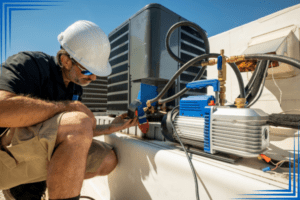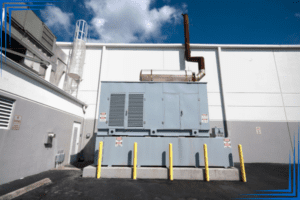As a commercial HVAC/R technician, you understand the vital role climate control plays in industrial warehouses. Maintaining the right temperature and humidity is crucial for product integrity, employee comfort, and overall operational efficiency. However, keeping a massive warehouse space cool can put a significant strain on your client’s budget. Here’s a comprehensive guide to help you navigate strategies for controlling HVAC/R costs in industrial warehouses, ensuring optimal temperature control without breaking the bank.
Understanding the Energy Drainers: Warehouse-Specific Challenges
Industrial warehouses present unique challenges for HVAC/R systems. Here are some key factors contributing to higher energy consumption:
- Large Open Spaces: Extensive volume translates to a larger area to cool, requiring more powerful systems and higher energy usage.
- High Ceilings: Warm air naturally rises, concentrating heat near the ceiling in warehouses with high ceilings. This uneven temperature distribution can lead to inefficient cooling.
- Frequent Door Openings: Loading docks and employee entrances create constant air leakage, allowing warm outside air to infiltrate the cooled space.
- Heat-Generating Equipment: Forklifts, machinery, and lighting can significantly contribute to the overall heat load within the warehouse.
- Variable Occupancy: Many warehouses experience fluctuations in occupancy throughout the day or week. Maintaining a constant cool temperature during non-operational hours can be wasteful.
Optimizing Efficiency: Strategies to Reduce HVAC/R Costs
By implementing strategic measures, you can help your clients achieve significant energy savings in their warehouse HVAC/R systems:
- Conduct a Thorough System Inspection: Regular maintenance is key. Perform a comprehensive inspection of the HVAC/R system, identifying potential leaks, clogged air filters, or malfunctioning components. A well-maintained system operates more efficiently.
- Upgrade to High-Efficiency Equipment: Consider suggesting investments in newer, high-efficiency HVAC/R units. While the initial cost might be higher, long-term savings through reduced energy consumption can be substantial.
- Implement Zoning Strategies: Divide the warehouse into designated temperature zones depending on specific needs. Areas with sensitive inventory may require cooler temperatures, while storage areas can function at a slightly warmer setting. This zoning allows for targeted cooling, reducing unnecessary energy use in less critical areas.
- Seal Air Leaks: Identify and seal any air leaks around doors, windows, loading docks, and ductwork. Even small leaks can allow for significant infiltration of outside air, forcing the HVAC/R system to work harder.
- Install Dock Seals and Shelters: Loading docks are major culprits for air infiltration. We recommend installing dock seals and shelters, which create a temporary seal between the warehouse and the trailer during loading and unloading, minimizing air exchange.
- Utilize Natural Ventilation: During cooler weather, implement natural ventilation strategies like opening warehouse doors and roof vents. This can reduce reliance on mechanical cooling systems.
- Optimize Lighting and Equipment Usage: Encourage energy-efficient practices like using LED lighting and turning off machinery and lights during non-operational hours. Less heat generation translates to less strain on the cooling system.
- Install Occupancy Sensors: Consider installing occupancy sensors in warehouse areas with fluctuating use. These sensors can automatically adjust cooling based on occupancy, preventing unnecessary energy consumption.
- Invest in Smart Thermostat Systems: We recommend installing smart thermostat systems that learn occupancy patterns and automatically adjust temperatures for optimal efficiency.
Building a Collaborative Approach: Partnering with Warehouse Management
Effective cost control requires collaboration between HVAC/R technicians and warehouse management. Here’s how to foster a productive partnership:
- Conduct Joint Energy Audits: Regularly conduct energy audits with warehouse management to identify areas for improvement. This collaborative approach ensures all parties are invested in finding cost-saving solutions.
- Educate Warehouse Staff: Provide training sessions for warehouse staff on energy-efficient practices. This could include strategies like minimizing door openings and turning off equipment when not in use.
- Monitor Energy Consumption: Encourage warehouse management to implement energy monitoring systems. Tracking energy consumption can also let you know if you have equipment that may need replacing if consumption spikes.
Check Your Industrial HVAC/R Compressor
If your industrial HVAC/R compressor is struggling or is over 8-10 years old, it might be time to consider replacing it with an affordable remanufactured compressor. Remanufactured industrial HVAC/R compressors are just as good as OEM compressors and may be better in some technicians’ opinions because they are more affordable than their OEM counterparts. Learn more about the industrial compressor remanufacturing process here.












